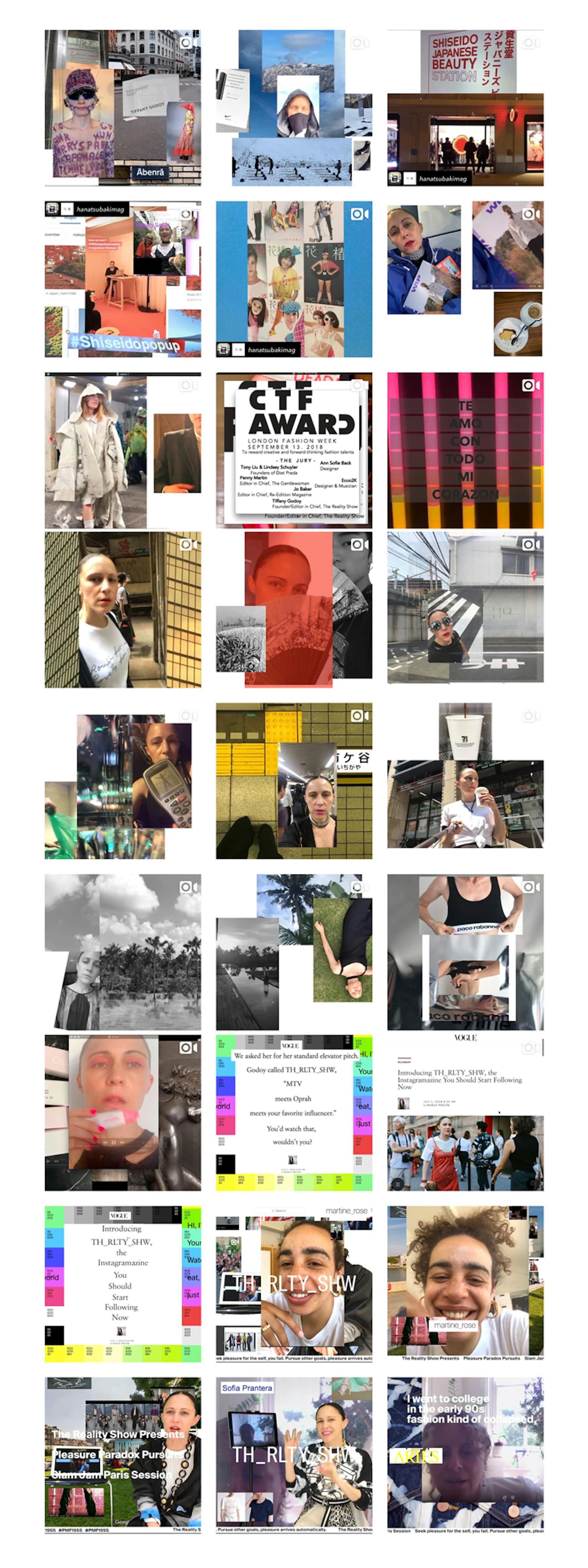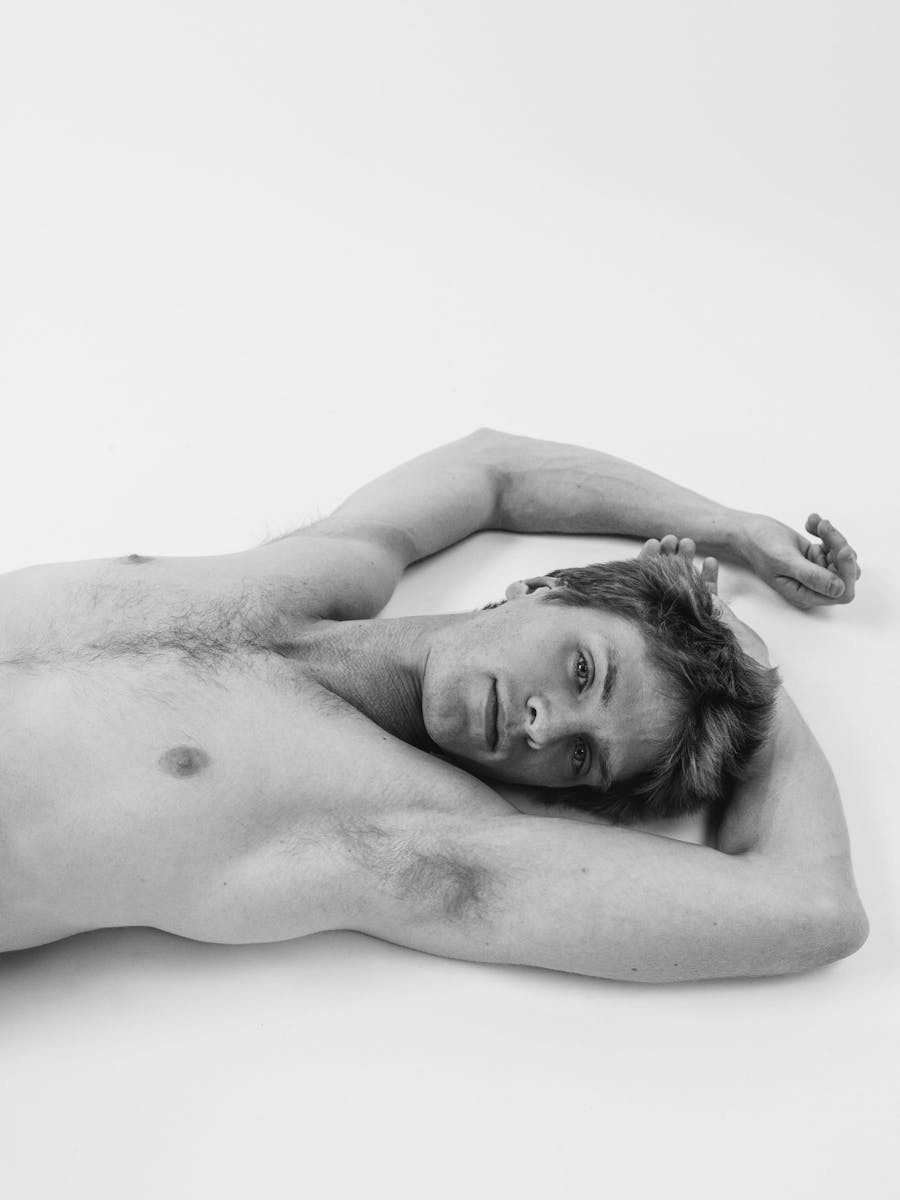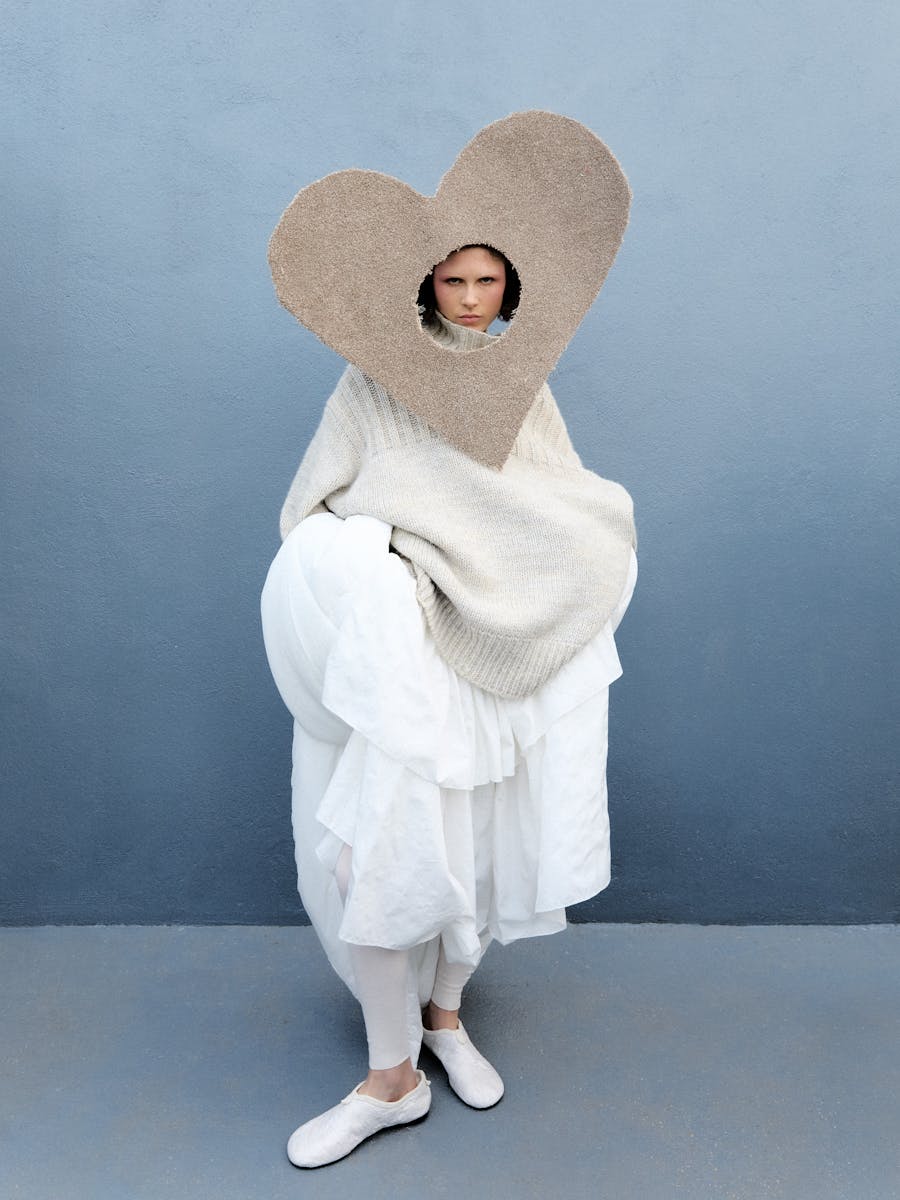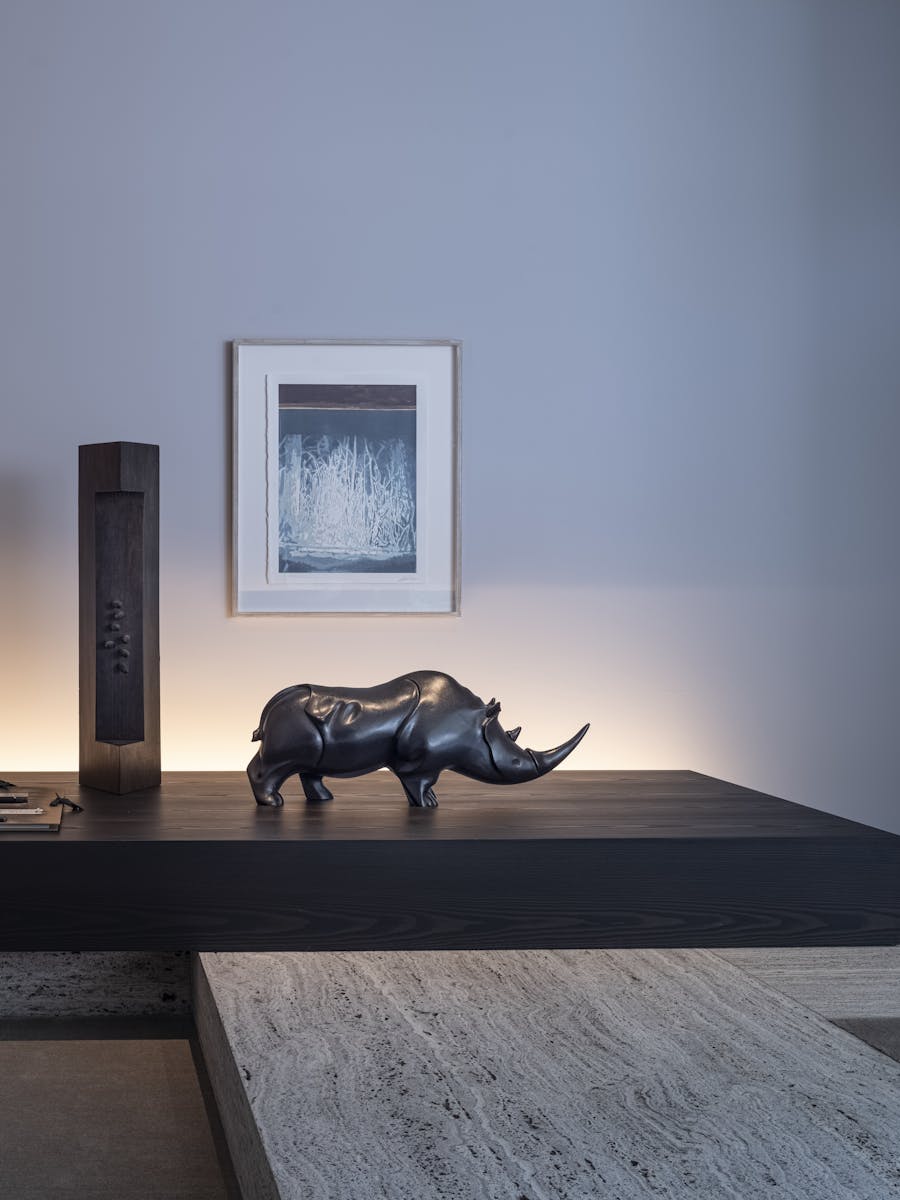In the platitudinous serfdom of a life regulated by habit, man tears himself away from the possibilities of being what he dreams of, to reconcile himself to the nightmares of what he won’t be. To realise one’s self in the gaze of a family, of a business, is that the worst kind of vassalage ? Is that not the real avatar ? This being whose identity is no longer the result of an autonomous choice, but a response to perceived expectations. In this new world, fashion can save us as well as imprisoning us. When it is the fruit of a discourse which imposes appearance onto being, fashion is imposing an avatar. To re-establish horizontality and promote the experimentation of an emancipated fashion, Tiffany Godoy has, since the beginning of her career, incorporated new technological tools to construct The Reality Show, a third place, located on Instagram: “a more practical means of communication and self-expression for me.” A virtual anthropological project which is none the less just as real as this magazine, whose pages occasionally need to be moistened if one is to turn them. In The Reality Show technique is no longer the twin of a real world, it is in the service of that world and enables a new experience of fashion. The idea of a separated avatar disappears, to the benefit of a celebration of the culture of the avatar – in other words a culture of freedom to be through permanent change, without a psychologizing aspect. For Tiffany Godoy, “it doesn’t matter whether we’re talking about virtual space or real space, man is inclined to perform, to put on a show. That’s a reality. Hence the name The Reality Show.”
— Of flesh and digital sinews.
Is the avatar the self dominated by the gaze of the other ?
Godoy’s eye is the camera of an anthropological fashion. It is located at the extremity of a nerve ending transformed into the selfie stick she holds in her own hands. She carries it to the four corners of the world. Sometimes she lends her selfie stick to other figures from the world of art and fashion: stylists (like Palomo Spain) or artists (@katiemonster). Fashion immediately takes on a different valence, because it is from the point of view of the locutor that the viewer sees the world. “The classic fashion magazine is based on a top-down principle of communication. The Reality Show is a hybrid between the documentary form and YouTube culture. The idea of equality. But also of a content which has been worked upon and which requires a journalistic disciple. Finally, it calls into question the boundaries of fashion; it is playing with different modes of address. I wanted to smash elitism and document, quite simply, the way in which the people who have the power live and create. To experiment, to act as a guide in everyday situations and invert the hierarchies.” Thus we find the playlist of the journalist Tim Blanks whilst he is preparing Fashion Week. In other words, we find an exploration of life which has become something rare in a society where the ideal of the avatar slyly suggests a simulation of the exceptional.
Through the setting up of this scopic regime, Godoy puts an end to the feeling of domination. Camera and image are one and the same. She orchestrates gazes and re-establishes control over the image in which she appears, demonstrating that the virtual is as controllable as the real. “All access is a myth. We only ever show a part of one’s self. It’s real, and at the same time, it’s not. The game at the moment is to use the virtual and to inject in it signs of the real to destabilise it. But finally the strip tease is never a strip tease. We are controlled by the image.”
The Reality Show transcends the moral panic according to which the avatar has swallowed the man. “For a long time, artists have constructed other ways of being. For me there are several types of avatar which correspond to different ways of constructing and managing the image. Artists such as Petra Collins produce self-portraits, but with the stamp of the aesthetic which means that the universe constructed is a filter which masks what they really are.”
— Career ? Avatar.
If this culture of the avatar is experiencing a renewal in the digital era, it has nonetheless always existed. “I think that there’s this culture of navigation and experimentation and on the other hand there are those who become a personality.” A privilege or a punishment that the laurels of fame impose on celebrities. Does power generate an avatar ? “I’ve discussed this on many occasions with Caroline de Maigret and she pointed out that the most famous people in the fashion world are those who never change their uni- form. Karl Lagerfeld, Anna Wintour. They are their own avatars.”
The everyman avatar, on the other hand, is emancipa- tory. “The avatar is perhaps that part of ourselves which asks only to realise itself. When I use the selfie stick there is a rumble of exci- tement. People see a camera and they start to perform in response to fulfill the desire of the person behind the camera. But if they are hol- ding the stick, the relationship changes. The individual can express things that they would otherwise hide, can combat their shyness. The selfie stick gives you the possibility of being who you would like to be in daily life: cooler, more seductive. Is that the culture of the avatar ?” In place of the disturbing idea of the avatar, the culture blossoming from this figure is like a promise of empowerment, of a free and autonomous navigation.
— Nomad, vagabond
Is the avatar the homebody ? Looking out through a single window ? “The idea with The Reality Show is to bring people with me when I travel. I want them to experience what I experienced when I first went to Japan. I was looking all around me, all the time. I was fascinated and I don’t want to lose that feeling.”
For Godoy, not taking the opportunity to travel stops people from fully developing. “It’s a need. It’s organic. As soon as I can, I leave.” Bangkok, Paris, Tokyo, Helsinki, Shanghai, New York, Hong Kong: a non-exhaustive list of the towns Tiffany has stayed in in the past three months. An equation which seems impossible, superhuman. Is she really here in Paris? Has she become an Instagrammable hologram, made up of the light rays of the countries she passes through ? In The Reality Show, she channels the cosmopolitan world and allow local cultures space to breathe at a time when the idea of the global world threaten to suffocate them. “French culture is very physical, very expressive. You have to be present in the interaction, whereas in Japan emotions are concealed. People don’t reveal anything. Technology then became a means of expressing one’s self whilst maintaining that restraint. The telephone is your constant companion. People have been their own media for much longer than in Europe because they live in a monoculture. The media are both their friends and their window onto the world.”
To perceive is to see man as well as his shadow (sorry Plato). To understand fashion in each country Godoy also takes as much interest in the media coverage of the designers as in their stories. Always accompanied by the camera-eye, she remains fascinated by technological developments but also by innovations in the way objects and customs are used. “It’s a technology, it’s not virtual but at the same time that’s modernity – inventing objects which make everyday life easier. What fascinates me is understanding how, from one region to another, for one person to another, the object becomes something else. How it is transformed through use.” In the end, how in the workings of everyday life, an object becomes the avatar of what it had initially been.
« In a way I'm a translator »
The culture of the avatar brings with it a deracination: it’s a reduction to a space, the essentialization of a being to its roots, which helps an individual to become tributary avatars. Wherever she is, Tiffany Godoy is always and absolutely herself.
She is the eye; the mobile translator we take on as a guide to discover the world. “I began to live in Tokyo in 1997 so none of this is new for me. My experience, my ability to communicate, is what made people curious over time.” Godoy could have been that American with an unheard-of knowledge of Japanese culture, could have become that avatar who responds to one of contemporary fashions’ demands, but instead she constantly surprises and escapes us.

— Incarnating fashion
Is the avatar the person who effects a metamorphosis to belong to a group ?
At the age of 16, my friends in LA were choosing between buying a car and having a nose job. Plastic surgery is no longer a big deal, in the US at any rate. Doubtless plastic surgery is linked to this culture of the avatar, of change, but is different from one country to the next. It is fascinating in Japan to see the number of hairdressers and make-up artists on the street. People change hair styles, change their face, at the drop of a hat. It’s fashion that’s most important. Being fashion.” As a social phenomenon, fashion is underpinned by an unchanging principle of constant change. In response to this paradox, for the Japanese everything is grist to the mill. “What’s interesting is that in Japan in the 1990s, youth subcultures talked about dressing like skaters. The “like” is important. The group to which teenagers wanted to belong was easily identifiable. Today I think that the group no longer has any precise name. It’s fashion, it’s luxury, as young people understand it. They mix Gucci, Balenciaga, the aim is always to be as radical as possible, and to show that off. It involves combinations that you wouldn’t see in fashion magazines and that’s what I’m looking to document, to capture.” Beauty is an important point of The Reality Show. Access to the prêt-a-porter collection remains the privilege of an elite: as a result, avatar culture extends to the physical. Skin colour, hair and nails change constantly. The debates around the metamorphosis of Kim Kardashian find an echo in this culture of the avatar. It’s not about asking who the person resembles or on what group they have modeled their look, but to what group they do not belong. “The culture of the avatar is about looking like so many things that the question of imitating a specific group becomes irrelevant.” In certain cultures, the refusal of change is so violent that fashion becomes of supreme importance. “Everything is summed up in ‘Have a Look’. In Japan, fashion is not the translation of a belief or a reflection: it’s about showing yourself. In the US, we cannot read things in the same way. The national creative context is different.”
The desire to translate one’s appearance changes across time according to cultures and countries. What can we learn from this? In becoming nomadic, access to fashion makes the idea of roots a paralyzing avatar.
— The culture of the exhibition is a Reality Show
The idea of the hybrid is prominent in a virtual age which promotes self-recreation. We have lives, digital as well as real, which our identities navigate. This creates new languages, which function in everyday life. People talk about themselves using they. They’ve superseded pigeonholes like he or she. Avatar culture is materializing in the real.
Killing the avatar is seeing whether there remains a man with needs, feelings, emotions behind it. It’s the aim of pretty girls in science fiction. With Tiffany, the virtual is forgetting to control your life. “I think people just need to relax, it’s necessary at this moment in time. Taking a moment for one’s self, reconnecting with nature and with other people. The selfie stick, in my view, enables us to decentre the gaze and to live the experiences with another person. To be more connected than ever, to be more present to one’s self than ever.” So Tiffany leaves to relax with a pop music avatar. “The new Mariah Carey album, Mimi, or Mariah, whichever.”
Translated into English by Sara & Emma Bielecki




